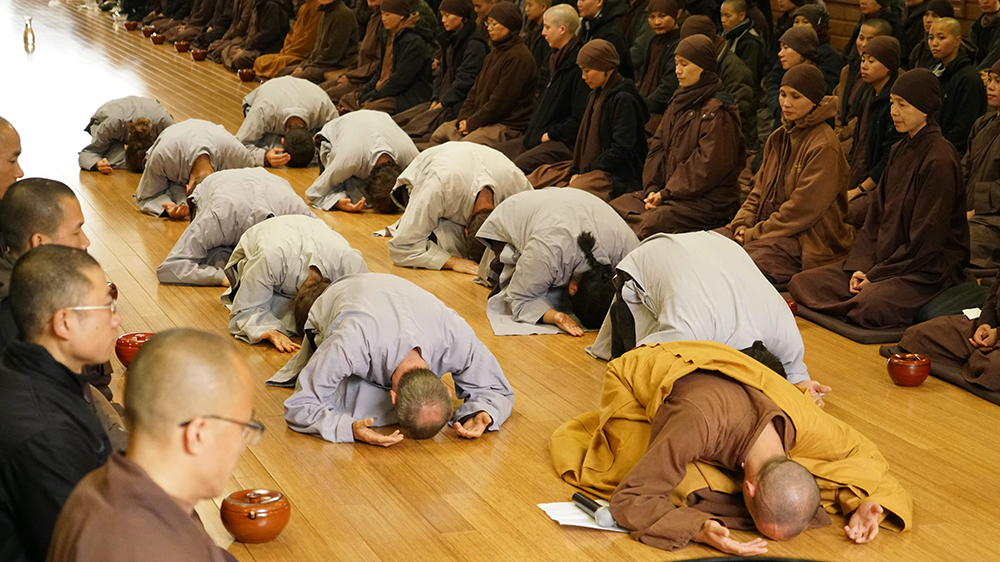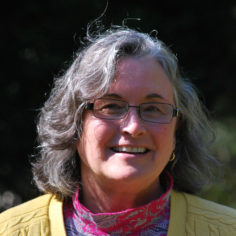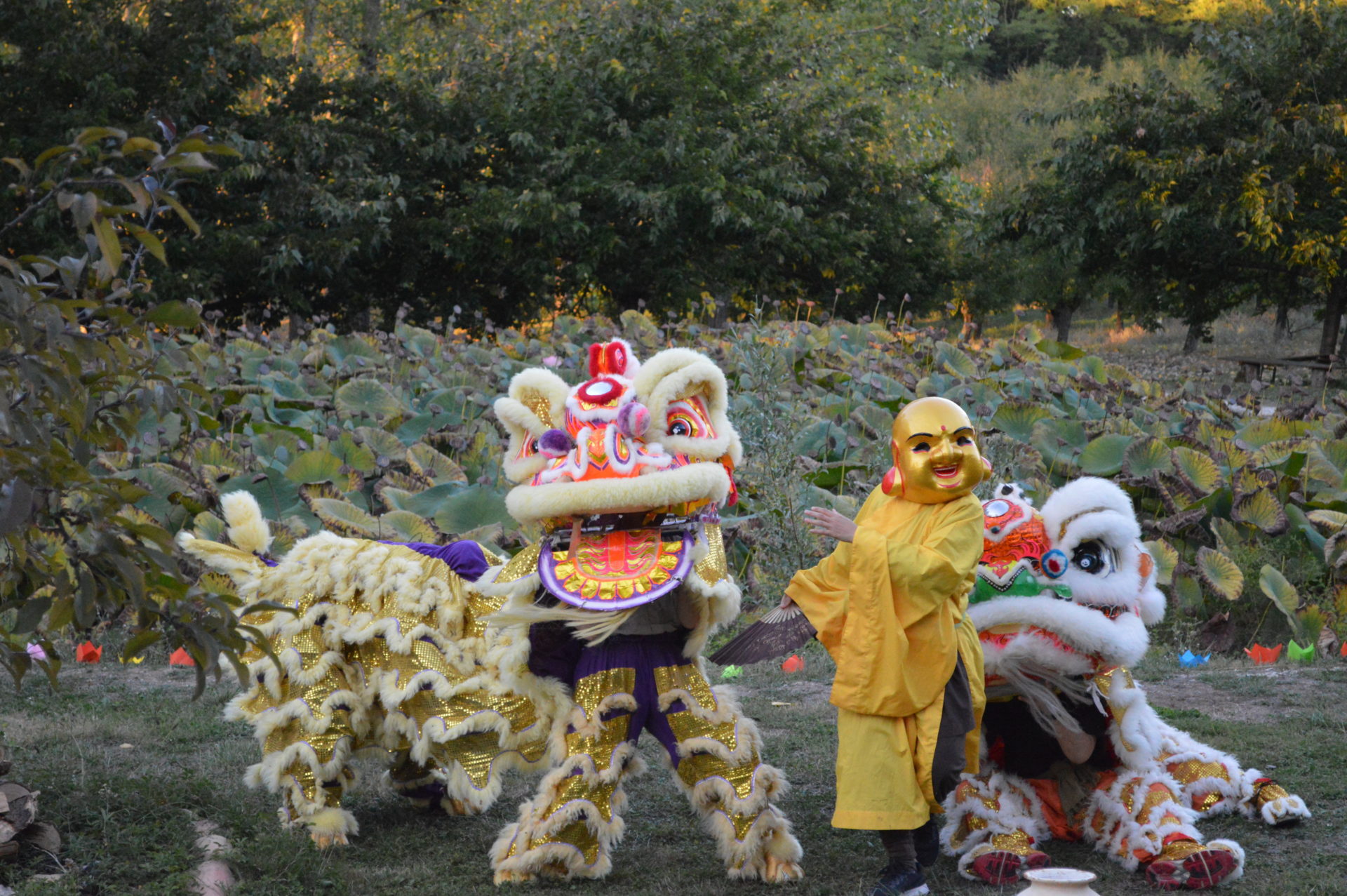Reflections on Touching the Earth
By Leslie Rawls in February 2019

Mist drifted across the Pacific mountain meadow as Sister Chan Khong’s voice guided several hundred retreatants in meditation beneath towering redwoods. It was 1993 and my first encounter with a practice I came to treasure: the Five Touchings of the Earth.
Reflections on Touching the Earth
By Leslie Rawls in February 2019

Mist drifted across the Pacific mountain meadow as Sister Chan Khong’s voice guided several hundred retreatants in meditation beneath towering redwoods. It was 1993 and my first encounter with a practice I came to treasure: the Five Touchings of the Earth. This beautiful practice has transformed my ability to offer love and understanding to myself and others in ways I never dreamed possible.
Touching the Earth involves two parts: a guided meditation and a yogic posture of physical prostration. The prostrations are a kneeling bow with your forehead on the floor, hands alongside your head. The physical prostrations deepen and enrich the practice for me, but in our Sangha and on our small retreats, I invite people who are not comfortable with the postures—for physical or other reasons—to experience the practice as a guided sitting meditation while the rest of us adopt the prostrate position. We begin in a standing posture and practice mindful breathing to center ourselves for a few breaths: “Breathing in, I know I am breathing in. Breathing out, I know I am breathing out.” Then we begin the guided meditation portion of the practice by focusing our attention on a different aspect within ourselves for each of the five Touchings. We stand with this awareness for a few moments before moving into full prostrations and continue the meditative focus. In my experience, even those who begin with some skepticism can taste a deeply moving connection and wholeness through this practice. It may help to schedule time so the Touchings are followed by Noble Silence or sitting meditation, in order to allow each practitioner to absorb the experience.
In the first three prostrations, we touch our roots: first the roots of our blood ancestors in ourselves, then the roots of our spiritual ancestors, and finally the roots of our land ancestors. In the last two Touchings, we send the positive energy of our ancestors: first to those we love, including ourselves, and finally, to those who we believe have caused us harm.
Each of the first three Touchings presents both joy and challenge. For example, part of my blood ancestry is deeply rooted in the American South. I descend from people who moved from Massachusetts in the mid-1700s. It is possible this white branch of my ancestors participated in slavery; I know they fought in the Confederate Army during the American Civil War. Of course, I do not defend or condone the cruelty and degradation of slavery, bigotry, and hatred, but these things are present in my blood ancestry.
Through Touching the Earth, I accept and acknowledge both the beauties of my ancestry and this shameful heritage, so that I can undertake to transform it in my life. This practice connects me in a loving way with both the positive and negative aspects of all my ancestors. I see they suffered and I see how their suffering spilled over to others, including me. With this acceptance I’m ready to transform the suffering and to cultivate the positive qualities of my ancestors in my own life.
The first Touching invites us to connect with our blood ancestors, recent and ancient. I have long seen my late father when I looked in the mirror or at my hands. But this practice invites me to touch him in a completely different way—not to see myself as a finished person with a physical resemblance, but to find my father directly in every cell of my body, in my breath, in my entire being. By Touching the Earth, I experience the truth that I’m part of the stream of life, not a finished product that stands alone.
Some people feel a lot of pain around their blood family. This first Touching can help heal that pain, but for a few of us, the pain is so strong that it is extremely difficult to touch our parents' presence in us this way. When our parents were physically or sexually abusive, a gentler approach may allow our awareness of this root to unfold more slowly and lovingly. Perhaps it is best to skip a generation as we begin to take up this practice. We could touch our grandparents or an aunt or uncle who offered us love. If even this approach is not possible, the practitioner may try to connect with themselves as small children, and slowly move into awareness of our blood relatives as children rather than as the adults who frightened, shamed, and hurt them.
When touching the second root—my spiritual ancestors—I connect with many teachings of love and compassion. Throughout my life, I have been blessed by connecting with beautiful, living spiritual teachers. I’m fortunate that my childhood church focused on love and service to others. “Love your neighbor as yourself” and “Do unto others as you would have them do unto you” were my first lessons in treating others with love and respect, taught both in my home and in the church.
Very specific faces come into my mind as I touch my spiritual roots—faces of people I have known, loved, and respected. Some are people who are in a teaching position with respect to me: Thay, my church ministers, Sunday School teachers, and so forth. Some are more my peers: my Order of Interbeing brothers and sisters, my Sangha-mates here in North Carolina, my friends in many other spiritual practices. Some people lived before my time or are strangers to me: Martin Luther King, Mary Magdalene, Abraham’s wife Sarah, Meher Baba, and so forth. Some are even children. And my spirituality is deeply rooted in what I have learned from all of them, and they are each part of the spiritual energy of my daily life.
Thay has encouraged us to recognize that perhaps those who taught us in our root spiritual tradition made mistakes, that they were not always able to transmit the teachings well. In this touching, we are encouraged to forgive this very human limitation and see the positive qualities offered by these ancestors, transmitted in the teachings that have nourished us. As we reach back through the stream to see our connection to spiritual teachers from earlier times, we connect with the spirit of love and compassion, the heart of the teachings transmitted to us. We see these teachings as present in our teachers and through them, in us. These ancestors touch us not through our blood, but through our tender hearts.
The third touching brings us in contact with our land ancestors: those who built our homes and schools, those who help feed us, and so forth. I always feel enormous gratitude in this Touching. While I find the American Confederacy in my blood family, here I connect with the slaves of the American South and recognize how much they are part of me, and I am grateful. I see my friends and colleagues who work to preserve the Earth and its bountiful life.
I’m aware of the many hands that work to put food on my table and nourish me. I see the migrant farmworkers who pick the fruits and vegetables. I remember that many of them are children. In my Touching, I feel deep gratitude for their efforts. I know that I have been nourished by their sweat and their tears, as well as the fruits of their labor. I see the hands of the farmworkers in the food I eat and also, in my whole being. Truly, they are me and I am them.
When we connect deeply with these three roots, our hearts brim with the loving, wholesome qualities of each. We naturally begin to reach out, and with the fourth Touching, we consciously share this energy with those we love. Sister Chan Khong adds “including my own small self,” when she leads this meditation. It’s a beautiful reminder that we need the love, too, and in my experience, an important part of this fourth Touching.
A curious aspect of the fourth Touching is that we may find ourselves sending love to ancestors we touched in one or more of the first three prostrations. My mother is present in this Touching as well as each of the three earlier Touchings. The “stream” becomes circular and our interconnectedness even more apparent and beautiful. Some people like to add another Touching, in the spirit of the metta meditations, and also send this energy to one for whom we have neutral feelings. This can be a very powerful method to transform neutral feelings into positive, loving ones. What a wonderful way to enhance our daily interactions and promote peace in the world.
As many of us might expect, the last Touching can be the trickiest: offering wholesome, loving energy to one who has caused us harm. But the more we work with this practice, the more spacious our hearts become and the better able we are to offer love to even this difficult person. In her book, Learning True Love, Sister Chan Khong writes of difficulty with a bureaucrat when she was working with the School of Youth for Social Services in Vietnam. She tells of reminding herself that even he was a “Buddha-to-be,” although, she says, “a difficult Buddha-to-be.” I smiled when I read this the first time, knowing that I had encountered my own “difficult Buddhas-to-be” and have even been one myself, no doubt. It’s a true and useful reminder that perhaps can help us defuse anger or frustration we might feel toward someone with whom we experience difficult relations. Thinking of him or her as a Buddha-to-be, though perhaps a difficult one, can help our hearts begin to open wide enough to include this person.
Over time, as our practice deepens, we clearly experience ourselves as part of the stream of ancestors, and we see that others, even those who have caused us great harm, are also part of a stream. While we may still choose not to put ourselves in a dangerous situation or remain in a situation that is toxic to us, through this fifth Touching our hearts can become as vast as the ocean and we are better able to offer love completely and unconditionally, even to those who have caused us harm.
I am aware that the Touching the Earth practice is sometimes difficult when our suffering is great or intimately associated with our direct ancestors. For example, it can be a tremendous challenge for people who were abused as children by someone they loved and trusted. Practicing with a group of supportive friends can help somewhat in this regard, even when the other folks don’t know our specific difficulty.
Taking another perspective may also help. Thay suggests that we see our mother and father as innocent children, and recognize that they too suffered. Sister Chan Khong has offered the image of our parents as young men and women full of love, hope, and promise. Both these gentle approaches help open our hearts to those whose suffering has spilled over and hurt us so deeply, whether our parents or another person.
One of the most valuable gifts of this practice has been its power in my relationship with my children. I have beautiful, wonderful children, and we are not biologically related. My husband and I adopted our children when they were babies. When I first touched the earth in that Pacific mountain meadow, I knew this was a practice I wanted to share with my beloved children. At the same time, I wondered where I would fit into their Touchings if they took up the practice. I learned that some people include adoptive parents in the blood family Touching.
While this may work for some people, it feels unsuitable to me. At one time or another, an adoptive parent is likely to wish that their precious child was also their biological child. Our love for our children is so strong, so woven into the fabric of our beings that the wish naturally arises. To include myself in the blood family Touching seems to encourage this fantasy, which I don’t find beneficial. Eventually, I realized that if my children pick up this practice, I might belong in their spiritual family. Each time I touch my own spiritual family, I begin with “the one who first taught me to love”—my mother—so seeing myself in this Touching for my children was a natural extension.
But my own practice of Touching the Earth gave me another, unexpected benefit with regard to my children. As I came in closer and more loving contact with my own ancestors, I began to see the presence of ancestors in people around me, including my children. I began to see that my children’s biological parents are in every cell of their body, in their movements, in the light of their eyes and the bells of their laughter. Immense gratitude wells up in me for the gift of life that these people gave to my children.
I cannot imagine loving anyone or anything more than I love my children. Thanks to the practice of Touching the Earth, I love them wholly. I can touch their biological parents present in them and offer love and acceptance to this aspect of their being. Through this practice, I have become capable of loving my children as whole beings.
Like all our practices, each person’s experience with Touching the Earth practice will differ. The truth is found in our own experience, not in duplicating the experiences of others. I love this practice enough to want to share it. In my experience, it is a doorway through which we can experience wholly—holy—love and offer it to others.


